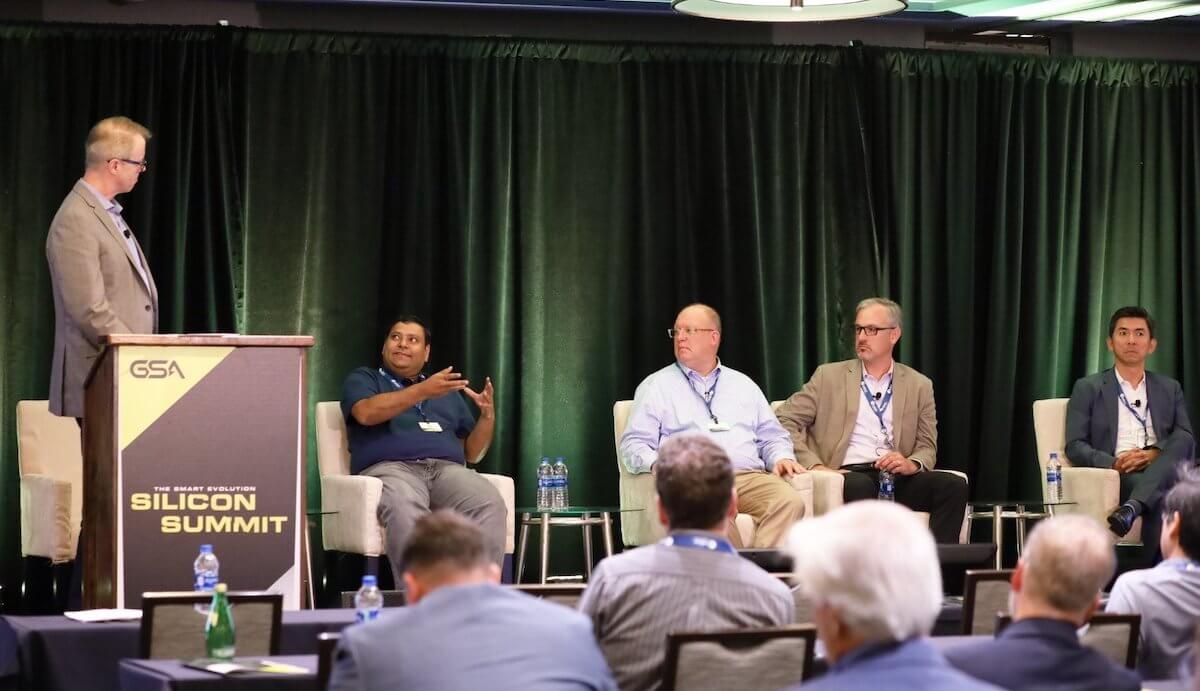 Recognizing the need fand value of semiconductor industry organizations, in 1994, Jodi Shelton and CEOs of fabless IC companies founded the Fabless Semiconductor Association (FSA). The traditional integrated device maker (IDM) business model was declining and the need for close cooperation between IC designers at fabless IC companies (Broadcom, Nvidia, Qualcomm, etc.) and more cost-effective wafer fab (at TSMC, UMC, Chartered, etc.) was increasing.
Recognizing the need fand value of semiconductor industry organizations, in 1994, Jodi Shelton and CEOs of fabless IC companies founded the Fabless Semiconductor Association (FSA). The traditional integrated device maker (IDM) business model was declining and the need for close cooperation between IC designers at fabless IC companies (Broadcom, Nvidia, Qualcomm, etc.) and more cost-effective wafer fab (at TSMC, UMC, Chartered, etc.) was increasing.
Within IDMs, informal communications and best practices assured efficient cooperation between design and manufacturing. As these functions got separated into independent corporations, rules for doing business, exchanging data, assigning responsibilities, sharing risks and rewards as well as means for educating and updating each other’s employees across corporate borders needed to be established. A need for semiconductor industry organizations became clear.
The FSA, under Shelton’s leadership, managed this IDM to fabless transition successfully, by organizing conferences and inter-disciplinary working groups to network, educate each other and learn to value each other’s complementary expertise. As the fabless and foundry cooperation proved highly successful, the FSA transformed in 2007 into the Global Semiconductor Alliance (GSA). This new semiconductor industry organization broadened its scope to accelerate market acceptance for a wide range of innovations.
Today’s GSA leadership team, Chair: AMD’s Lisa Su, Vice-Chair: ARM’s Simon Segars and many successful high-level executives set the organizations directions. Jodi Shelton as CEO, Shrikant Lohokare, NA Executive Director & Global VP, Sandro Grigolli, EMEA Executive Director and VP, as well as several teams in Asia execute them and run the business.
The 2019 Silicon Summit: A Semiconductor Industry Organization at Work
I am a strong believer in good communication and cooperation within firms and across companies. Since I founded eda 2 asic in 2002, I have contributed to several semiconductor industry organizations, e.g. SOI Consortium, Sematech, Si2, ESD Alliance, SEMI and GSA. I managed the GSA’s 3D-IC Working Group from early 2008 until the end of 2012 and really got to value the passkey “GSA”, when I needed support from GSA member companies. Since 2008 I have attended many GSA events and continue to appreciate the GSA’s contributions to accelerating the adoption of innovative technologies in our semiconductor industry. The latest such event was the GSA Silicon Summit on June 18. It is the subject of this blog.
Fast-tracking Silicon and System Design for the Edge
Keynoter, SiFive’s CEO Naveed Sherwani, introduced his company as part of the rapidly growing RISC-V Ecosystem. It enables processor innovations through open standards collaboration. Sherwani sees a lot of opportunities in edge computing (Figure 1).

For making edge nodes intelligent, he suggested to let SiFive’s RISC cores do the inference, instead of relying on ASICs. He substantiated SiFive’s tag line: “Silicon at the speed of software” and explained: SiFive and RISC-V partners not only offers software routines but also customizable processor core IP and a development environment. The many RISC-V building blocks enable engineers to create designs in a fraction of the time an ASIC would take. Such design “tape-outs” don’t incur mask or prototyping cost. A designer only needs a workstation with internet access to create a solution.
IoT Security From the Chip to the Cloud
Speakers from ARM, Cisco, Intrinsic-ID, NXP, and Zingbox addressed this critical topic. Networked devices; like smartphones, security cameras, printers, and wearables; if not secure, enable hackers to get into proprietary networks. The presenters outlined how their products and services mitigate the risk of getting hacked. Cisco’s Anoop Nannra suggested learning from the Trusted IoT Alliance on how to secure networks and devices. The key message from all speakers: Security must be designed in up-front!
Smart, Connected Industries and Infrastructure
Adesto, NEXT Biometrics, and Rambus talked about how innovations like IoT, AI, and big data analysis will initially disrupt industries, then make them more productive. For example, Sohrab Modi from Adesto summarized his mission (Figure 2).

Modi and the other speakers gave many examples of how cities and companies can benefit from simultaneous data exchange between IoT devices and big data analysis in edge servers or the cloud. The transition from reactive to proactive operations need to be well planned, keep security in mind and require top management support.
Empowering the Edge: Ubiquitous Computing and Connectivity
Speakers from Quicklogic, Ericsson, Cypress and ASE emphasized that it takes domain expertise to design and make IoT edge nodes productive. Additionally, it’s very important to plan top-down to get real value out of data edge nodes capture. ASE’s Yin Chang summarized the key challenges for implementing an IoT edge node and emphasized that advanced packaging is an effective means to serve these applications (Figure 3). Chang described the ASE Toolbox and mentioned its cooperation with Cadence for integrating edge node functions in advanced packages.

Transformation of Mobility: The Tip of the Iceberg
Autonomous vehicles are on everybody’s mind today and GSA invited speakers for this topic too. KPMG, LeddarTech, FLEX, ARM, and Savari showed how products/services can change our mobility significantly – when underlying technologies have matured, infrastructure and legal support are in place. Savari’s Paul Sakamoto stated that car accidents kill 40.000 people per year and injure about one million more. Over 90% of these accidents are due to human errors – lots of opportunity for improvements.
As an example of the benefit of semiconductor industry associations, GSA members can download all presentations here, to catch up on this interesting and productive day. ~ Herb


















